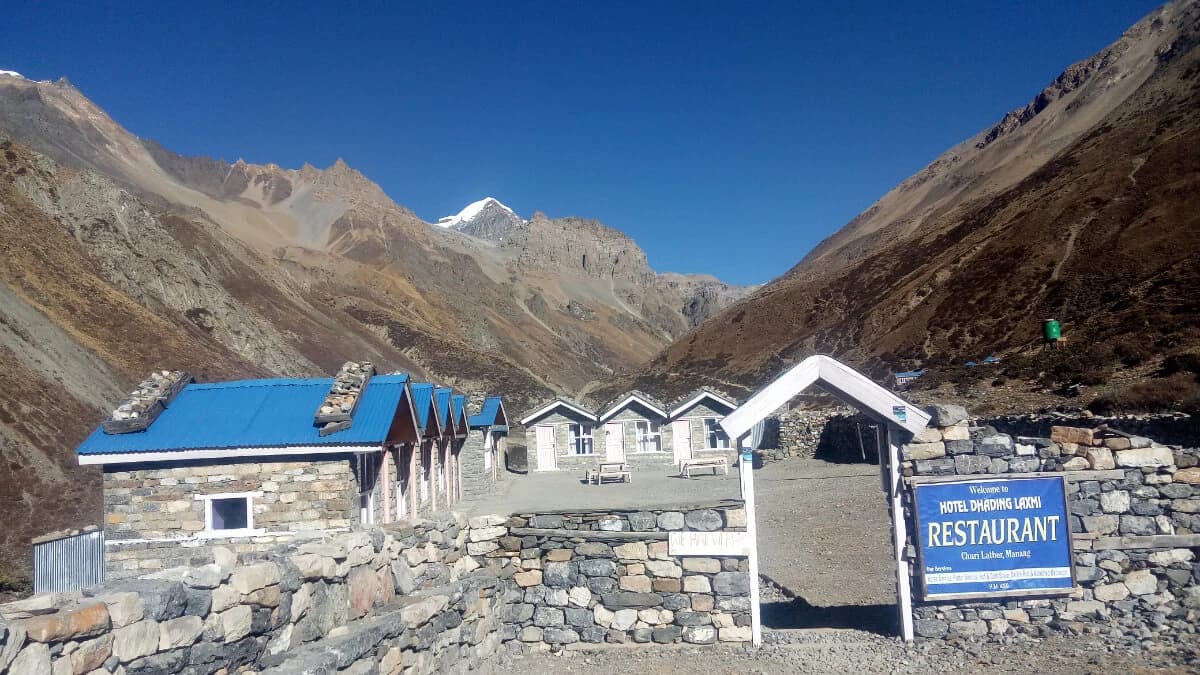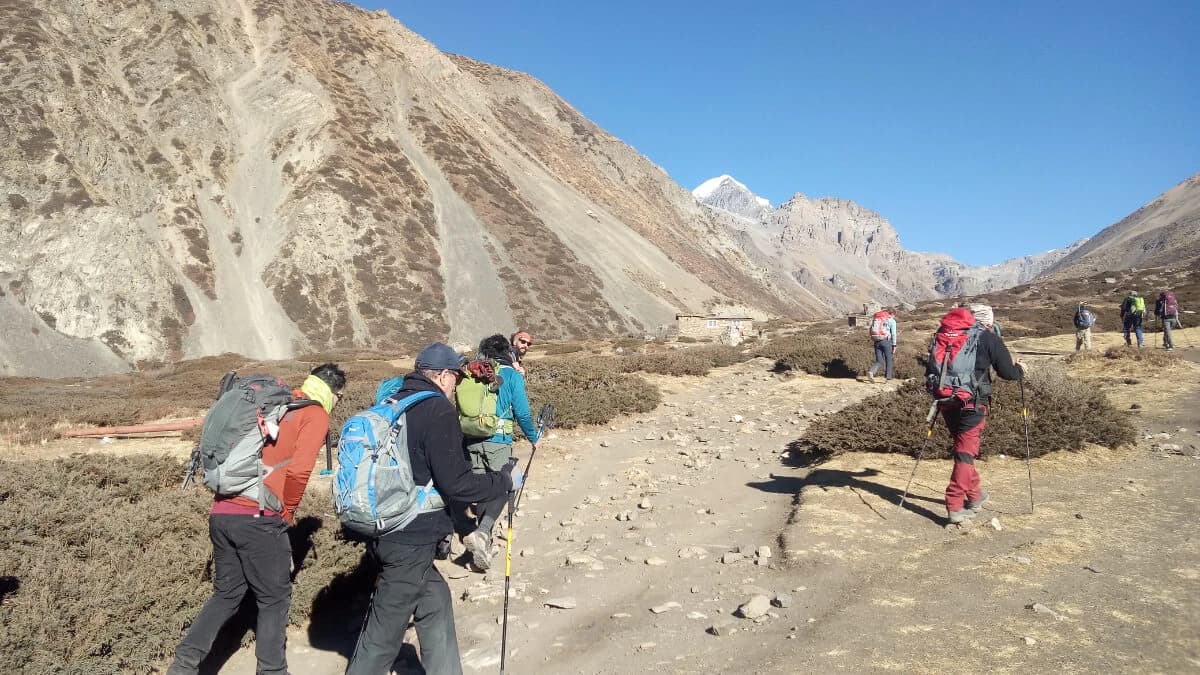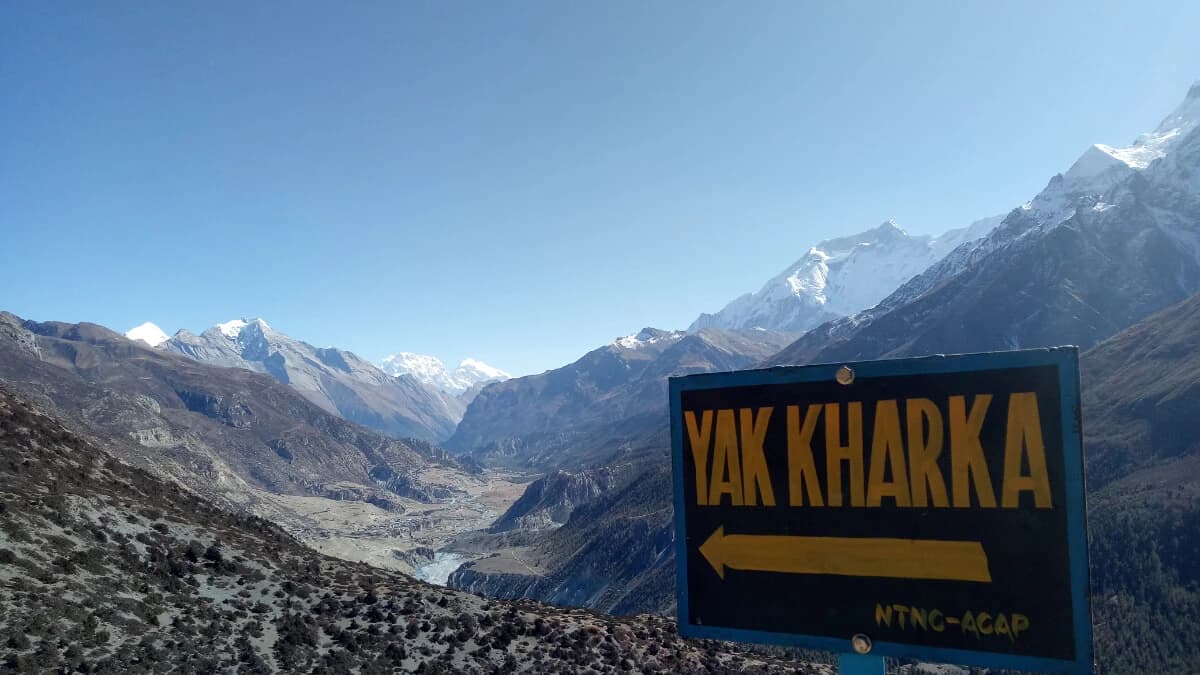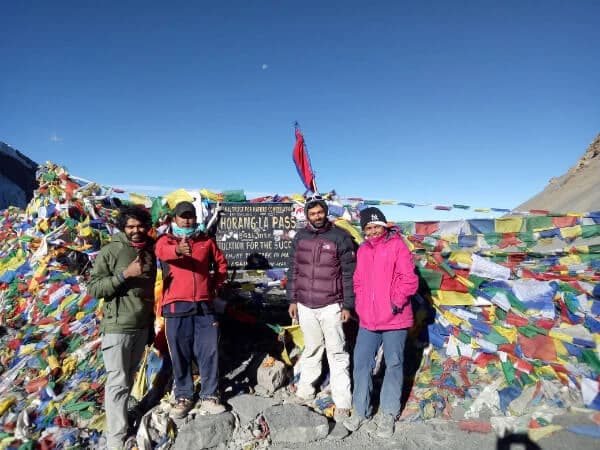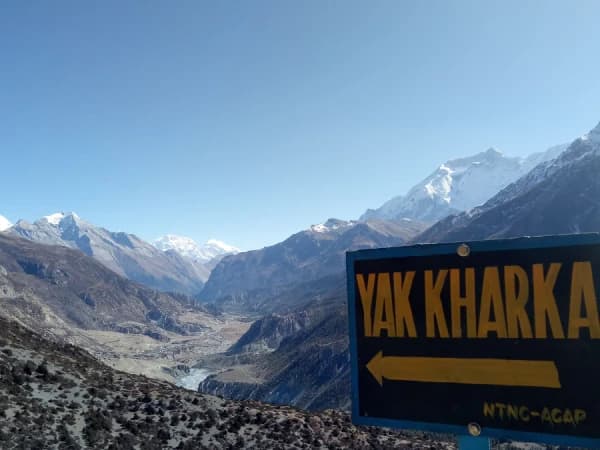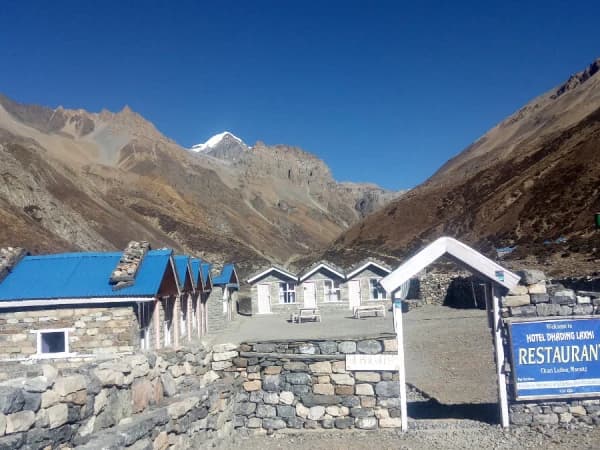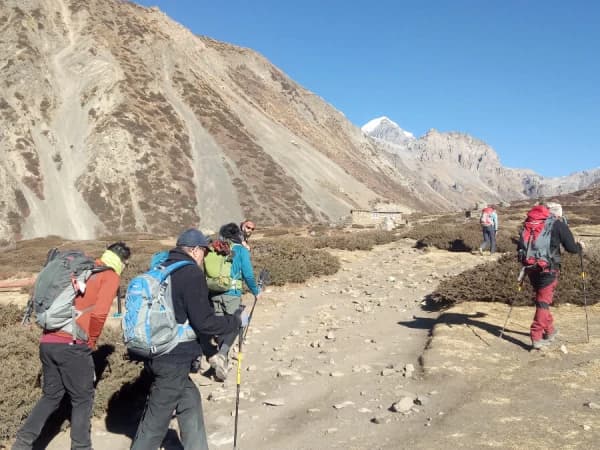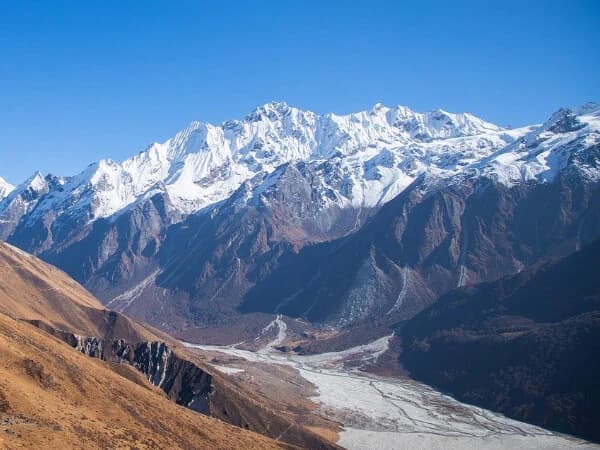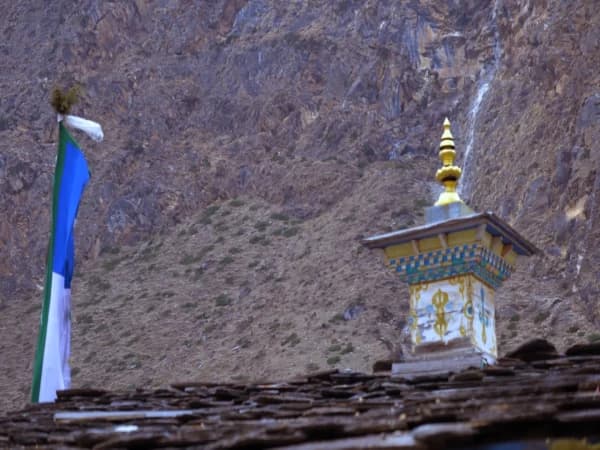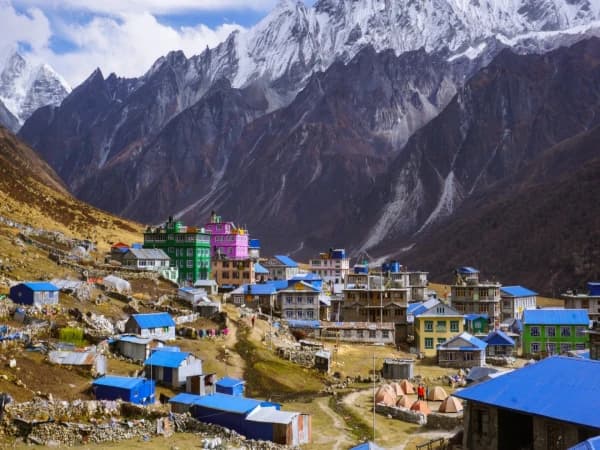The Short Annapurna Circuit Trek is a 10-day Himalayan adventure through Nepal’s most scenic trails, perfect for trekkers seeking high-altitude thrills in less time.
Short Annapurna Circuit Trek - 10 Days
Highlights of the Short Annapurna Circuit Trek
- Thrilling High-Altitude Adventure: Experience the excitement of climbing to 5,416 meters at the Throng La Pass, offering an adventurous challenge.
- Diverse Landscapes and Flora: Trek through varied terrains, including oak and rhododendron forests, rice fields, and glacial zones, while discovering the rich biodiversity of the Annapurna Conservation Area.
- Cultural Immersion: Engage with the local communities such as Gurung, Lama, Tamang, and Bhote, learning about their Buddhist traditions and mountain culture as you pass through picturesque villages.
- Sacred Sites and Historical Temples: Visit ancient monasteries and the holy Muktinath Temple, revered by both Hindus and Buddhists, along with other historical sites on your journey.
- Stunning Himalayan Vistas: Enjoy breathtaking views of some of the world's highest peaks, including Mt. Annapurna, Thorung Peak, Nilgiri, Chulu, Tukuche Peak, Dhaulagiri, and Lamjung Himal.
- Post-Trek Exploration in Pokhara: After completing the trek, explore the beautiful city of Pokhara, including boating on Fewa Lake and enjoying the Pokhara Valley Tour.
- Monasteries and Natural Wonders: Visit the largest monastery in Manang at Braga and marvel at stunning waterfalls, deep gorges, and the diverse natural beauty of the Annapurna region.
The Short Annapurna Circuit Trek stands out as a top choice for trekking in Nepal, offering an unforgettable adventure in the heart of the Himalayas. Starting from the vibrant city of Pokhara, the gateway to the Annapurna region, this trek is designed for those with limited time but a strong desire to experience high-altitude trekking.
The Short Annapurna Circuit Trek takes 10 days and provides stunning views of the Annapurna Himalayan range, along with glimpses of Manaslu and Dhaulagiri. The route begins at an altitude of 800 meters and climbs to 5,416 meters at the Throng La Pass, passing through diverse landscapes, including rice paddies, subtropical forests, rural villages, and glacial zones.
Trekkers will encounter the serene beauty of the Annapurna region's snow-capped peaks. The Annapurna Circuit Trek passes through communities such as Gurung, Lama, Tamang, and Bhote, who follow Buddhist traditions. Their warm hospitality and simple lifestyle are truly heartwarming, and their ethnic attire, often adorned with gemstones, adds to the cultural richness of the journey.
Choosing the Short Annapurna Circuit Treks means immersing in the local cultures of the Annapurna region, with a perfect blend of high-altitude trekking and breathtaking mountain scenery. The trek includes panoramic views of some of the world's highest peaks, including Mt. Dhaulagiri (8,167m), Mt. Annapurna I (8,091m), Mt. Manaslu (8,163m), and many others.
The Short Annapurna Circuit Hike starts with a drive from Kathmandu to Chamje, followed by a trek to Chame, the headquarters of the Manang district, where trekkers can enjoy a natural hot spring. On the sixth day, the trek reaches Manang, with an extra day allocated for acclimatization. The route continues to Throng High Camp, followed by an early morning departure to cross Throng La Pass, connecting Manang village to the sacred Muktinath Temple. After crossing the pass, the trek descends to Muktinath, a site of significant religious importance.
The Short Annapurna Circuit Hiking concludes with a drive to Pokhara, passing through Jomsom and the Kali Gandaki River's windy valley. In Pokhara, trekkers can explore the city's natural beauty and visit Fewa Lake. Recreation Holidays offers various trekking packages in the Annapurna region, ensuring a memorable experience.
For those with additional time, options like the 12-day Annapurna Circuit Trek or the Annapurna Circuit Trek with Tilicho Lake 15-days are available. The Short Annapurna Circuit Trek is a protected journey within the Annapurna Conservation Area Project (ACAP), ensuring both adventure and environmental preservation.
Preparing for Your Short Annapurna Circuit Trek
Once you’ve booked the Short Annapurna Circuit Trek, it’s time to get ready. Depending on your fitness level, allocate between one to six weeks for training to enhance your strength, stamina, and focus. Break in your trekking boots and gradually gather your trekking clothes and gear. You can purchase or rent equipment, with rental options available in Kathmandu.
Ensuring a Safe and Hassle-Free Trek with Recreation Holidays
At Recreation Holidays, we strive to make your Short Annapurna Circuit Trek in Nepal a seamless and enjoyable experience. We offer carefully curated trekking packages that cater to modern trekking expectations. With our well-designed and reasonably priced packages, you will trek with experienced guides and have all arrangements, including permits, pre-organized.
Upon arrival in Kathmandu, you’ll explore the city, pack your duffle bags, and start trekking without delay. Our team handles all the logistics, ensuring no hidden costs and pre-informing you of any additional expenses. Safety is our top priority, with well-trained mountain leaders ensuring a secure trekking experience.
Cost and Booking for Short Annapurna Circuit Trek 2025/2026
The cost of the Short Annapurna Circuit Trek can vary based on the itinerary, services, and group size. Customizing your trek itinerary to fit your needs is always an option. Trekking in a group of five or more can offer a better per-head deal.
Our bookings for the Short Annapurna Circuit Trek 2025/2026 are now open. For any assistance, please don't hesitate to contact us and start planning your adventure.
Conclusion: The Short Annapurna Circuit Trek is your gateway to high-altitude adventure, spiritual discovery, and the breathtaking beauty of the Annapurna Conservation Area. From crossing the iconic Thorong La Pass to visiting sacred temples and warm village communities, every step is inspiring. Recreation Holidays ensures a hassle-free, well-guided experience with expert support and customizable itineraries. Book your Annapurna trek in Nepal for 2025/2026 today and turn your Himalayan dream into reality.
Short Annapurna Circuit Trek - 10 Days Itinerary
Day-to-Day Itinerary for Short Annapurna Circuit Trek
Start your day with an early morning bus ride from Kathmandu to Bhulbhule via Besisahar. Upon reaching Bhulbhule, transfer to a shared jeep for the drive to Dharapani. The journey is filled with scenic beauty, including waterfalls, snow-capped mountains, and suspension bridges. You'll travel along the Marsayangdi River, passing through quaint villages like Ngadi, Bahundanda, Syange, Jagat, Chamje, and Tal. Upon arrival in Dharapani, you'll register your details and trekking permits at the police checkpoint.
Travel Time: 8 to 9 hours, Distance: 234 kilometers
Today, you'll venture deeper into the alpine region, where the climate becomes cooler. The trail leads through the Tibetan villages of Bagarchhap and Danakyu, set against a backdrop of lush forests. Along the way, enjoy views of apple orchards and the majestic Lamjung and Annapurna II peaks. Continue through the picturesque villages of Timang, Thanchowk, and Koto before reaching Chame. As the district headquarters of Manang, Chame offers various facilities including hotels, internet cafes, shops, banks, and health services. Don't miss the large mani wall adorned with prayer wheels at the entrance of the village.
The fourth day of Annapurna Circuit Trek starts with breakfast followed by walk through the beautiful forests of Rhododendrons and Pines, crossing the meadows and soaring mountains. You will pass through ascending and descending pathways crossing a few suspension bridges. It is quite easy walk arriving at the top hills names Paungda Danda and then continuing the walk, you will reach to Pisang. It might take around 5/6 hours to reach Pisang from Chame. Overnight stay at Pisang.
As the elevation increases, the trek will push your adrenaline to the edge. After breakfast, you will head to Manang village today. Pisang village has flat terrain. After walking a few hours, you will ascend a little bit to Humde. Your walk will entertain you with the astonishing views of Mt. Annapurna II, III and IV with Gangapurna himal, Tilicho and Pisang peak. As you go up and up, you will adjust with the elevations and the climate. This is one of the best times of the trekking when you get a chance to learn about the Tibetan settlements and its unique Buddhist cultures and traditions. You will then follow the northern trail via upper Pisang and Ghyaru from where you can have the spectacular views of Himalayas and the alpine lakes. This route might take a little longer but surely will give you stunning views. Overnight stay at Manang.
Acclimatization is crucial when trekking to higher elevations. Spend the day in Manang to allow your body to adjust to the altitude, helping to prevent any health issues. Explore the village and its surroundings, hike to scenic viewpoints and glacial lakes at the base of Gangapurna and Tilicho peaks. Immerse yourself in the local culture, visit monasteries, and explore the cultural museum. Rest well tonight to prepare for the next day's trek to Yak Kharka.
After breakfast, begin your trek to Yak Kharka, approximately 7 kilometers from Manang. The route takes you through local villages like Tan, across suspension bridges, and through cultivated farmlands. The trek is a moderate ascent of 2 to 3 hours, allowing plenty of time to rest and acclimate for the higher elevations to come. Relax and enjoy your evening in Yak Kharka, preparing for the next day's hike to Thorong Phedi.
Today's trek to Thorong Phedi is uphill and requires a steady pace. Take short breaks to hydrate and enjoy the stunning scenery. The trek takes about 4 to 5 hours, allowing for a slow and leisurely pace to aid acclimatization. Upon reaching Thorong Phedi, relax and prepare for the challenging trek over Thorong La Pass the next day.
Begin your day early, around 3 AM, to tackle the Thorong La Pass, the highest point on the Annapurna Circuit Trek, standing at 17,770 ft / 5,416 m. This segment is the highlight of the trek, providing breathtaking panoramic views. After reaching the pass, descend towards Muktinath for your overnight stay. Muktinath is a sacred destination cherished by both Hindus and Buddhists.
Today, you'll descend from Muktinath to Pokhara by local jeep or bus, soaking in the peaceful scenery of the lower Mustang Valley. The journey lasts about 8 to 9 hours. Upon arrival in Pokhara, unwind by the lakeside, indulge in various cuisines, and celebrate the completion of your trek.
After breakfast, head back to Kathmandu on a comfortable tourist coach. Enjoy the beautiful scenery of terraced farmlands, rivers, and waterfalls along the way. The journey takes about 6 to 7 hours. Once in Kathmandu, you'll be transferred to your hotel for some rest and preparation for your next destination or journey home.
Trip Service Details
Includes
- Private air-conditioned vehicle transfers for both arrival and departure are available upon request.
- 1 nights' accommodation in Pokhara on a bed and breakfast basis
- Public bus ticket to Bhulbhule from Kathmandu
- Sharing Jeep ticket to Dharapani from Bhulbhule
- Public bus ticket to Pokhara from Muktinath
- 8 nights' tea house accommodation during the trek
- Three meals a day (8 breakfasts, 9 lunches, and 8 dinners) during the trek
- An experienced English-speaking government-licensed guide
- 1 assistant trek guide for groups larger than 7 trekkers, including their food, lodging, transportation, salary, and insurance
- All necessary permits for the Annapurna Circuit Trek
- First aid medical kit
- Seasonal fresh fruits
- Achievement certificate available upon request
- Complimentary luggage storage during the trek
- Farewell dinner with traditional Nepalese food
- Emergency evacuation and rescues if needed (must be covered by travel and medical insurance)
- All the required taxes and official charges
Excludes
- Nepal entry visa fee
- International airfare
- Charges for extra luggage/baggage
- Expenses for extended stays
- Expenses for hot and cold beverages, alcoholic and non-alcoholic drinks, hot showers, internet or Wi-Fi, charging electronic equipment, snacks, etc.
- Medical and travel insurance
- Porter services $240 per porter (available upon request, 1 porter for every 2 trekkers)
- Lunch and dinner in Pokhara and Kathmandu in cases of early returns or late departures, regardless of the reason
- Expenses from natural disasters, mishaps, or unforeseen events (like weather or airline issues) that are non-refundable and non-transferable, including voluntary early departure or medical emergencies
- Tips for the staff
- Any other expenses not mentioned in the "Inclusions" section
Note: Porter services can be arranged based on guest requests.
Add-ons & Options
- Include a guided sightseeing tour in Kathmandu: Exploring some historical sites before starting the trek will give a humble beginning to your Annapurna Circuit trek. The tour will be guided by our friendly, English-speaking guide. You will also have the late afternoon and evening free to prepare for the trek. The guided tour costs USD 95 per person.
- Porter service: We have not included the porter service in our Annapurna Circuit trek packages, which gives you the option to decide whether you want it or not. A porter service for the Annapurna Circuit 10-day trek may cost USD 180 per person.
Transportation Cost Information for Annapurna Circuit Trek (Upgrade to Private Jeep)
Day 1: Kathmandu to Dharapani
- Upgrade Available: Switch from local bus to private jeep.
- Cost: $230.00 per jeep.
- Capacity: Up to 6 passengers per jeep.
Day 9: Muktinath to Pokhara
- Upgrade Available: Change from local bus to private jeep.
- Cost: $220.00 per jeep.
- Capacity: The Jeep accommodates 6 passengers.
Dates & Availability
Additional Info
Optimal Seasons for the Short Annapurna Circuit Trek
Spring – March through May
Spring is the prime season for the Short Annapurna Circuit Trek in Nepal due to its bright skies and sunny days. Although mornings and nights at higher altitudes can be chilly, daytime temperatures are generally mild. The clear skies offer excellent visibility, and there is no rain. The landscape is lush and vibrant, with rhododendrons, Nepal's national flower, blooming magnificently at lower elevations. Pine trees provide refreshing and aromatic surroundings, while other wildflowers add a variety of colors to the scenery.
Autumn – October through November
Autumn is another popular period for Annapurna Circuit Trekking. The weather is pleasant, the scenery is stunning, and the trails are bustling with trekkers. This season is in high demand for lodging due to the overlap of the festival season and peak trekking time. It's important to plan your trek accordingly. The festive atmosphere of Pokhara and the route enhances the overall trekking experience.
Physical Condition & Experience Requirements fo the Short Annapurna Circuit Trek
The Short Annapurna Circuit Trek is suitable for physically fit individuals of all ages who have previously engaged in moderate to strenuous physical activities. Expect daily walks of 5 to 7 hours with rest breaks. The trek spans one to two weeks at high altitudes and involves significant elevation changes, including passes over 4,000 meters. Ideal for experienced hikers with previous high-altitude trekking experience, this trek requires walking in snow and ice conditions. Participants should be in excellent physical condition and possess a positive mindset. Prior trekking experience is essential, though technical skills are not required. Those with pre-existing medical conditions such as heart, lung, or blood diseases should inform Recreation Holidays before booking and consult with their doctors prior to the trip.
Accommodations on the Trek
In Kathmandu, accommodations are provided in deluxe hotels to ensure a comfortable and relaxing environment before and after the adventure. Breakfasts are included at the hotel. Rooms are typically twin-share, with options for triple-share upon request. A single supplement is available at an additional cost of US$200. Recreation Holidays ensures clean and comfortable rooms, though some teahouses along the trek may only offer shared washing and toilet facilities. Single rooms are generally available at lower elevations but may be difficult to find at higher altitudes.
Meals During the Trek
Breakfast is provided as part of the trip itinerary while you are in the city. During the Short Annapurna Circuit Trek, three meals a day (breakfast, lunch, and dinner) are provided from the teahouse menus. Meals include a variety of options such as noodles, soups, bread, rice dishes, curries, spaghetti, pizza, eggs, potatoes, and fresh vegetables, ensuring a diverse and satisfying diet throughout the trek.
Drinking Water
Staying hydrated is crucial, especially at high altitudes. It is recommended to drink at least 4 liters of water per person per day. Avoid purchasing bottled water to help reduce plastic pollution. Teahouses provide cold water free of charge, which should be treated before drinking. It is advisable to bring a reusable bottle with a wide opening and a SteriPEN for water purification.The SteriPEN is a small, battery-powered UV water purifier, effective and quick ensuring you have safe drinking water throughout your trek in Nepal.
Travel & Medical Insurance
Before booking any trip, it is strongly advised to purchase medical and travel insurance. This insurance should cover emergency evacuations, medical bills, and travel issues. In case of emergencies, Recreation Holidays will assist with obtaining necessary documentation for insurance claims. It is important to provide your contact details as well as those of your next of kin or emergency contacts. Comprehensive travel insurance is vital for a safe and worry-free journey in the Nepal Himalayas.
Climate and Weather
Nepal's climate varies significantly by region. The low-lying Terai has a sub-tropical monsoonal climate, while the Himalayan foothills, where most treks occur, are best visited during the cool, dry season from September to May. October and November are generally considered the best months for trekking, offering clear skies and pleasant temperatures. Spring is also popular, with warmer weather and blooming rhododendrons. Visibility is good during these times, though nights can be cold, and snow is possible above 3,000 meters. Understanding the climate and weather in Nepal is essential for planning your Annapurna trekking adventure.
Altitude Sickness and Remedies during the Short Annapurna Circuit Trek
As trekkers climb to higher altitudes, the oxygen levels and air pressure decrease. The Short Annapurna Circuit Trek reaches an elevation of 5,416 meters above sea level, starting from a much lower altitude. Common symptoms of altitude sickness include nausea, diarrhea, headaches, loss of appetite, exhaustion, and sleeplessness, particularly when hiking above 3,000 meters. These symptoms need immediate attention to prevent further complications.
To avoid severe altitude sickness, trekkers must descend to a lower elevation promptly if symptoms occur. It's crucial to communicate with your guide and not hide your symptoms out of fear of being sent back. Proper acclimatization is essential to help your body adapt to the altitude. Staying hydrated, maintaining a steady pace, and following your guide's instructions are key to avoiding Acute Mountain Sickness (AMS). Additionally, abstaining from alcohol and smoking during the trek is highly recommended.
Recommended Equipment List for the Short Annapurna Circuit Trek
This Short Annapurna Circuit Trek packing list is designed to help you pack smart and light for a successful journey through the Himalayas.. It is not meant to be exhaustive but to serve as a reminder of essential items for your comfort and convenience. We recommend packing only what is necessary.
Head
- Warm hat that covers your ears
- Sunglasses
- Sun hat
- Headlamp with extra batteries
Upper Body
- T-shirts
- Fleece jacket or sweater
- Fleece wind-stopper jacket
- Waterproof shell jacket
- Down vest and/or jacket (optional)
Hands
- Lightweight gloves (waterproof/windproof)
- Heavyweight gloves or mittens with a waterproof shell outer
Lower Body
- Underwear
- Hiking trousers
- Fleece or woolen trousers
- Lightweight thermal bottoms
- Lightweight cotton pants
- Waterproof shell pants (preferably breathable fabric)
Feet
- Thin lightweight inner socks
- Heavy poly or wool socks
- Hiking boots with spare laces
- Camp shoes (sneakers or sandals)
Sleeping
- Sleeping bag (suitable for -10 degrees C / 14 degrees F)
- Fleece sleeping bag liner (optional)
Toiletries
- Toothbrush and toothpaste
- Multi-purpose soap
- Nail clippers
- Deodorant
- Medium-sized quick-drying towel
- Face and body moisturizer
- Small mirror
- Female hygiene products
Personal Hygiene
- Wet wipes (baby wipes)
- Tissue/toilet roll
- Antibacterial hand wash
Medical
- Small, personal first-aid kit (simple and light)
Extras / Luxuries
- Reading book
- Trail map/guidebook
- Journal and pen
- Travel game (chess, backgammon, playing cards, etc.)
- Modest swimsuit
- Binoculars
- Camera
Short Annapurna Circuit Trek - 10 Days FAQs
Yes, the Annapurna Circuit Trek is suitable for first-time trekkers. This trek provides a traditional route around the stunning Annapurna mountain range, featuring manageable high hills and offering breathtaking views. It is one of the most popular trekking routes in Nepal, making it a great choice for beginners.
The perfect times for the 10-Day Annapurna Circuit Trek are during the spring (March, April, May) and autumn (September, October, November) seasons. During these months, trekkers can enjoy sunny, warm days and clear blue skies, providing optimal weather conditions. There is usually no rain or snowfall during these periods, making the trek safe and enjoyable.
The duration for completing the classic Annapurna Circuit Trek typically ranges from 10 to 20 days. However, for those with limited time, an 10-day version of the trek is available.
The Annapurna Circuit Trek is considered challenging due to its high altitude, rugged terrain, and the region's remoteness. It demands good physical fitness and mental resilience.
While it is possible to undertake the Annapurna Circuit Trek without a guide, it can be quite challenging. Navigating the correct paths, selecting appropriate rest stops, and making informed decisions requires experience, particularly in high-altitude environments. Having a guide can significantly ease the journey and ensure safety.
The Annapurna Circuit Trek reaches its highest point at Thorung La Pass (5,416 meters). Gradual acclimatization is vital to prevent acute mountain sickness. Spending additional time in Manang, walking at a steady pace, and staying hydrated can help. The main risks include unpredictable weather and potential avalanches, but proper preparation can mitigate these dangers.
On the Annapurna Circuit Trek, some tea houses offer WiFi for a small fee, although connections can be unreliable. Mobile data is accessible in areas with coverage, provided by major networks like NCELL and NTC. SIM cards are available for purchase in Kathmandu.
Yes, you can charge your phone and camera batteries at teahouses, often for a nominal fee. Some teahouses might offer this service for free. Since power is typically generated by solar energy, it can be less reliable in winter. Carrying extra batteries or power banks is advisable.
Definitely! If you book a private trek, we can accommodate any customizations you wish to make. However, adjustments to group departure trips can be difficult and may not be fair to other group members.
Travelers’ Review
My journey through Nepal was nothing short of extraordinary. From the vibrant streets of Kathmandu to the serene beauty of Pokhara and the breathtaking trails of the Annapurna Circuit, every...
This was my second time in Nepal with Recreation Holidays. Before this trek, I had done the Annapurna Base Camp Trek, and this time I went for the Annapurna Circuit...
This is the first time that I came to Nepal, and before that, I had connected with Mr. Hari, the MD of Recreation Holidays, to go on the Annapurna Circuit...

